Overview
This article elucidates the seven benefits of adjustable pipettes in pharmaceutical laboratories, highlighting their crucial role in enhancing precision, efficiency, and sustainability in liquid handling. The discussion begins with:
- Improved accuracy, a fundamental aspect that ensures reliable results in drug formulation.
- Time savings, allowing researchers to focus on critical tasks rather than mundane adjustments.
- Ergonomic design, promoting user comfort and reducing fatigue during prolonged use.
- Integration of innovative technology, elevating their functionality and making them indispensable tools in modern laboratories.
Collectively, these advantages underscore the necessity of adjustable pipettes in optimizing drug formulation processes and upholding high-quality laboratory standards.
Introduction
Adjustable pipettes are transforming the landscape of pharmaceutical laboratories, where precision and efficiency are essential. These versatile tools not only offer customizable volume settings but also enhance workflow, alleviate strain, and improve accuracy in liquid handling. As the demand for high-quality liquid management solutions increases, it is crucial to consider:
- Are adjustable pipettes genuinely the key to optimizing laboratory performance?
- Do they simply introduce complexity into established practices?
JM Science Adjustable Pipettes: Enhance Precision in Your Lab
Adjustable pipettes from JM Science are engineered to deliver exceptional precision in fluid management, making them indispensable tools in drug laboratories. Their customizable volume settings enable precise measurements tailored to specific experimental requirements, ensuring that each transfer task is executed with remarkable reliability. This precision is vital in pharmaceutical labs, where can profoundly impact drug formulation and testing outcomes.
Recent advancements in flexible liquid handling technology have further augmented their functionality, incorporating features that enhance user experience and accuracy. For example, the integration of smart technology facilitates programmable settings and data recording, essential for maintaining consistency in high-stakes environments. Laboratory supervisors have noted that the use of flexible dispensers has significantly improved drug formulation precision, with one stating, "The accuracy provided by flexible dispensers has transformed our approach to drug development, minimizing errors and optimizing results."
The significance of accurate dosing on drug formulation outcomes is paramount. Inaccurate measurements can lead to ineffective formulations or adverse effects, highlighting the necessity for high-quality liquid handling tools. By ensuring precise liquid management, versatile instruments bolster the reliability of drug research, ultimately enhancing the quality of therapeutic products and patient safety. As the drug industry continues to advance, the demand for precise liquid handling solutions such as adjustable pipettes will only grow, underscoring their critical role in propelling drug discovery and development.
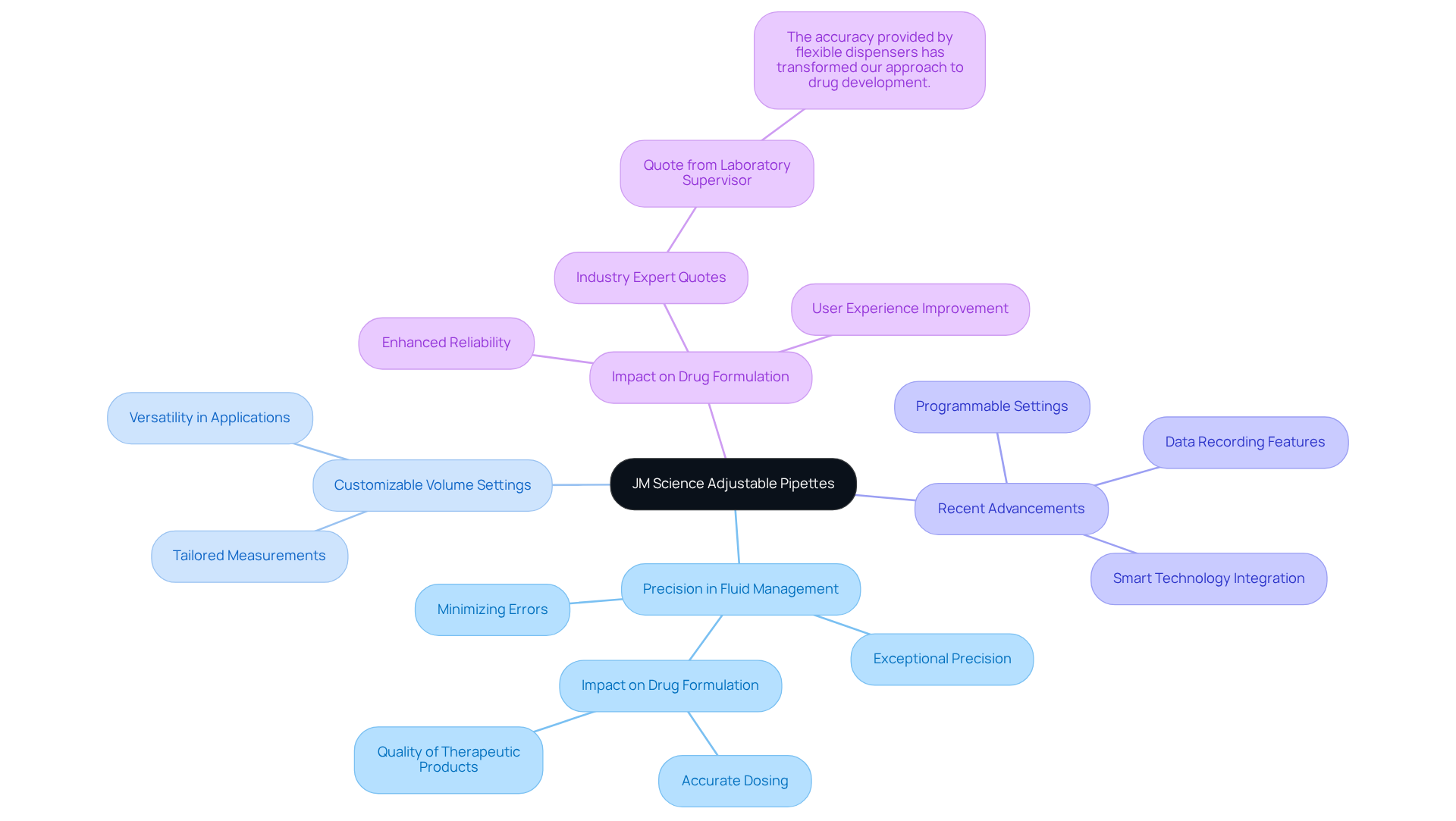
Save Time with Adjustable Pipettes: Streamline Your Pipetting Process
Adjustable pipettes represent a significant advancement in pharmaceutical laboratories, significantly decreasing the time needed for liquid transfers. By allowing researchers to swiftly adjust volumes, the adjustable pipette enables seamless transitions between tasks without the need to switch tools. This adaptability not only accelerates workflows but also diminishes the risk of , thereby enhancing overall efficiency.
Lab managers have reported that the use of flexible liquid transfer tools can decrease the time needed to fill microplates by over 75%, transforming routine procedures into streamlined operations. For instance, filling a 96-well plate with a single-channel instrument could exceed 20 minutes, making the time savings offered by versatile devices even more pronounced.
As one lab manager remarked, 'The efficiency enhancements we've observed with flexible liquid handling tools have been remarkable; they enable us to concentrate on essential research instead of repetitive tasks.'
In high-throughput environments, the ability to use an adjustable pipette to adjust liquid handling settings on the fly is invaluable, ensuring that laboratories maintain productivity while adhering to rigorous quality standards. Moreover, electronic liquid handlers reduce human variability and enhance reliability in lab applications, further supporting the case for adopting versatile dispensers.
Ergonomically designed electronic dispensers also alleviate physical strain during repetitive tasks, establishing them as essential tools that optimize liquid transfer processes in the fast-paced medical industry.
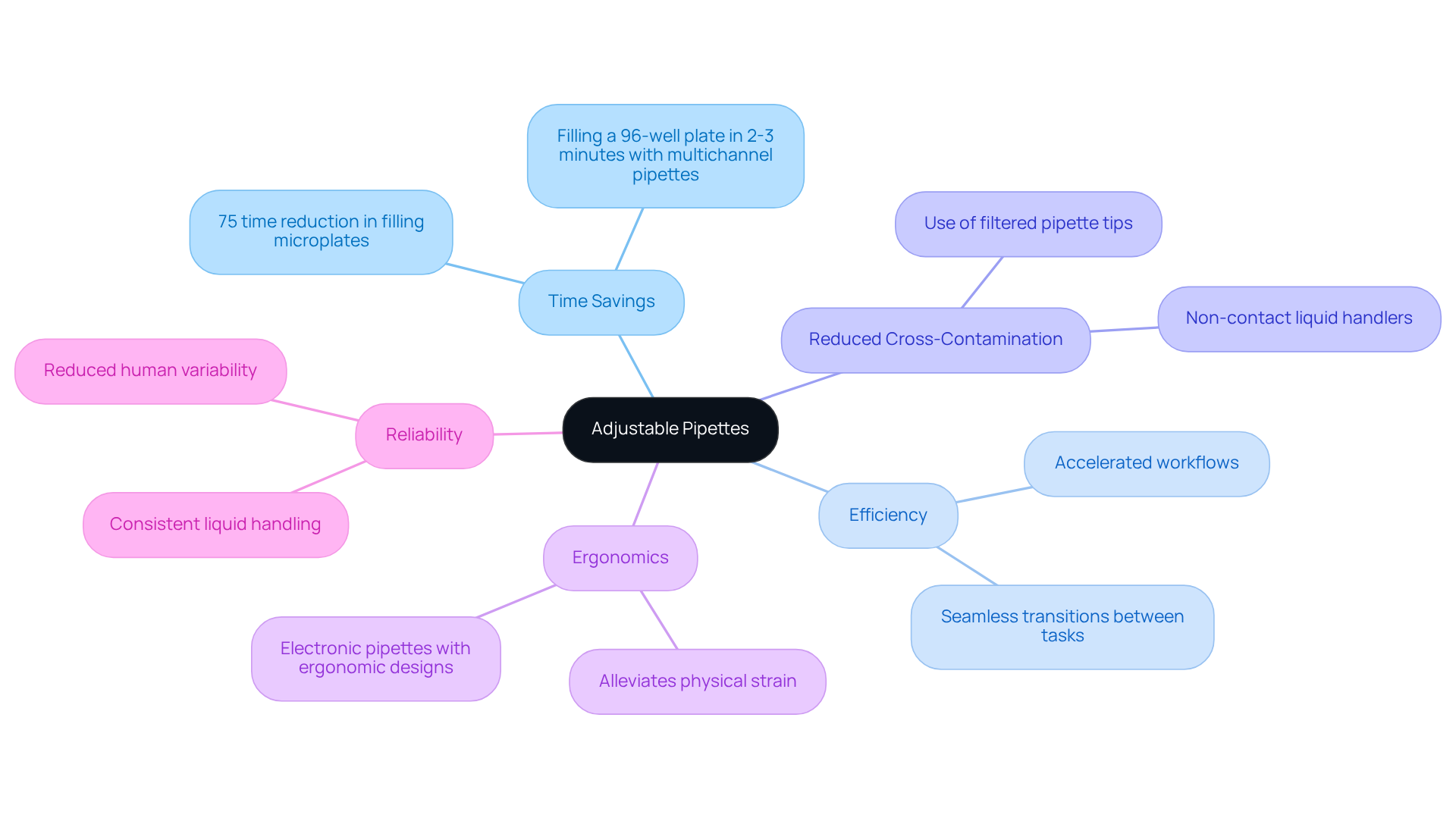
Ergonomic Design of Adjustable Pipettes: Reduce Strain and Improve Comfort
The ergonomic design of JM Science adjustable instruments significantly reduces hand fatigue and strain during extended use, capturing the attention of professionals in laboratory settings. With features such as:
- Lightweight construction
- Comfortable grips
- Low-resistance plunger mechanisms
These instruments enable researchers to work longer without discomfort. This is particularly advantageous in environments where personnel may spend hours engaged in repetitive pipetting activities. By prioritizing user comfort and efficiency, not only enhance productivity but also promote a healthier working experience for scientists.
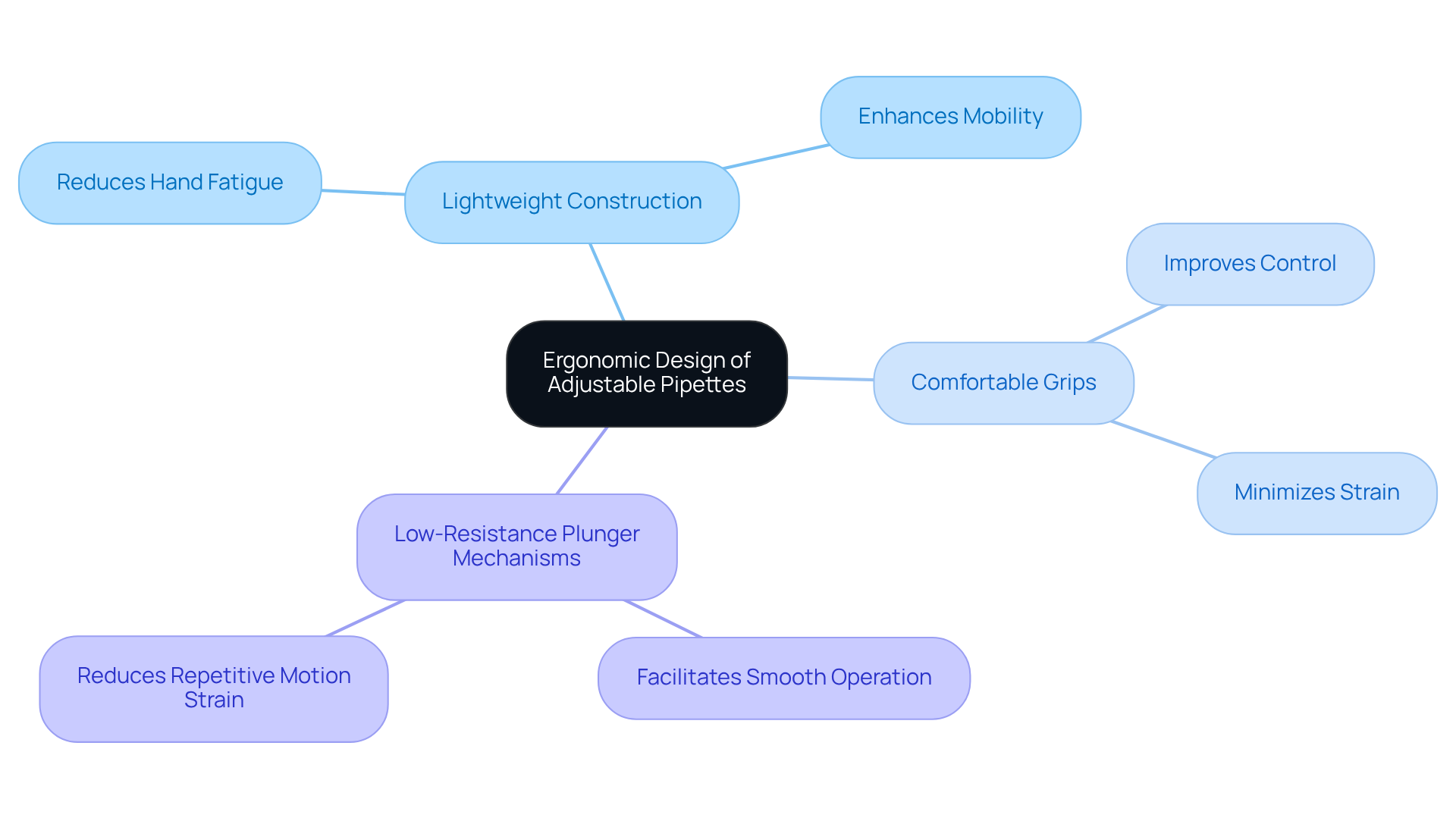
Electronic Features of Adjustable Pipettes: Boost Accuracy and Ease of Use
Adjustable instruments are increasingly integrating electronic features that significantly enhance their functionality. These innovations, including programmable settings for volume and dispensing speed, provide users with greater control and consistency in liquid handling. In pharmaceutical laboratories, where precise measurements are paramount, these features prove invaluable. Statistics indicate that electronic devices can enhance precision by minimizing human errors; for instance, numerous models, such as the Picus® 2 electronic instruments, achieve a variation of less than 1% between samples. As highlighted by Brandoch Cook, PhD, a freelance scientific writer, "Electronic dispensers are the preferred solution for efficiency, consistency, and reliability."
The ability to customize pipetting parameters not only streamlines workflows but also ensures that experimental results are reliable and reproducible. Programmable settings enable adjustments in liquid handling techniques, leading to more accurate outcomes in sensitive applications. Furthermore, the ergonomic design of electronic dispensers reduces user fatigue during prolonged use, enhancing their appeal in modern drug research facilities.
The integration of these advanced features establishes as essential tools in drug laboratories, driving efficiency and elevating the quality of research and diagnostics.
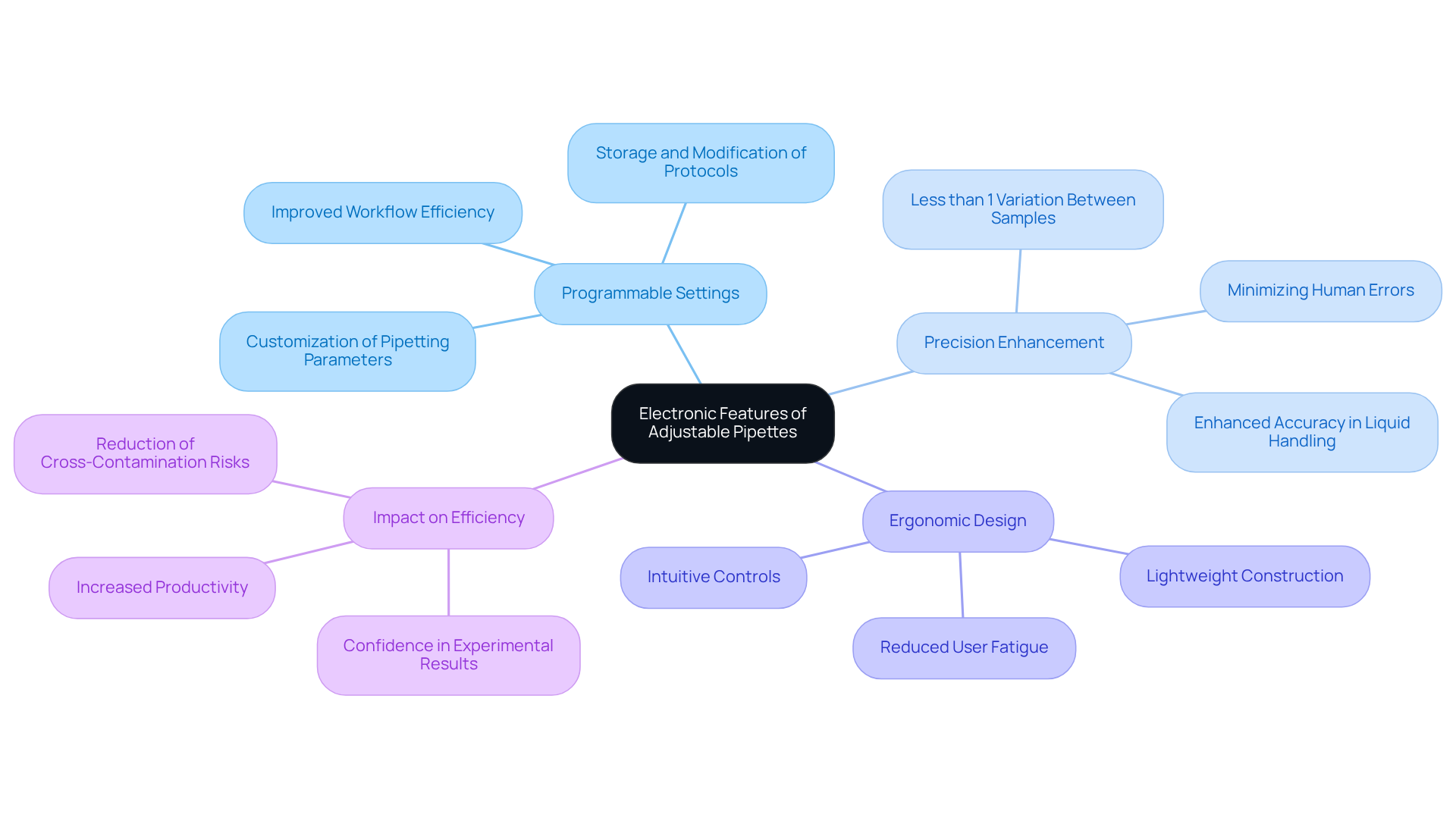
Cost-Effectiveness of Adjustable Pipettes: Maximize Your Lab Budget
Adjustable pipettes serve as a highly cost-effective solution for pharmaceutical laboratories. By significantly reducing the risk of measurement errors, these instruments minimize the necessity for repeated experiments, which can be both time-consuming and costly. The financial repercussions of inaccuracies in measurements can be considerable, resulting in wasted resources and extended project timelines.
Furthermore, the versatility of variable-volume tools means that fewer instruments are required for various tasks, thereby enhancing budget efficiency. Lab managers have noted that the implementation of flexible liquid transfer devices has led to substantial budget savings, as they optimize workflows and reduce the overall costs associated with liquid handling.
This combination of positions adjustable pipettes as invaluable assets in the pursuit of financial prudence within pharmaceutical research.
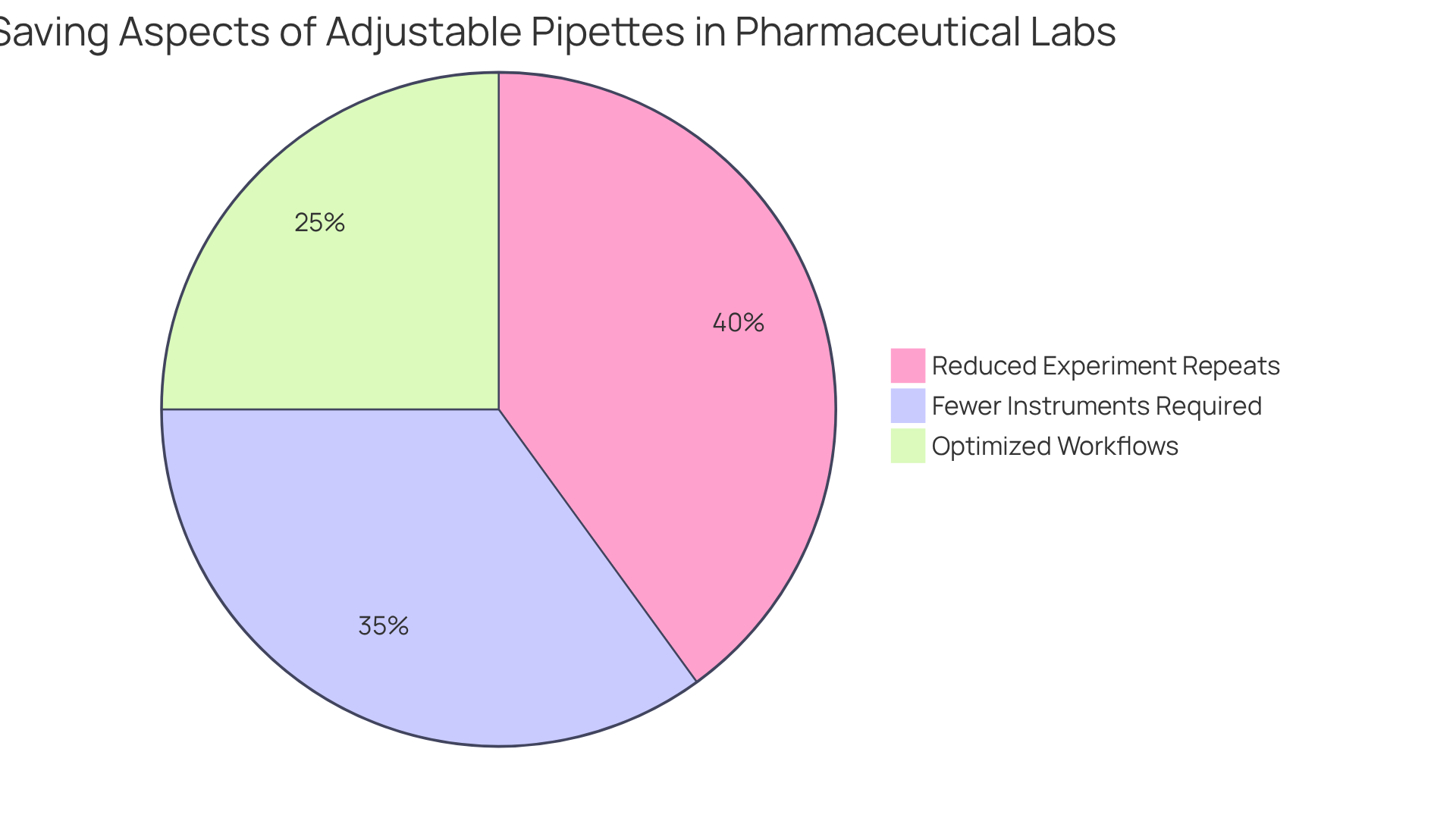
Sustainability of Adjustable Pipettes: Reduce Waste and Environmental Impact
Adjustable pipettes play a crucial role in advancing sustainability initiatives within research facilities by significantly reducing the dependence on disposable tips and other consumables. By allowing for precise volume modifications, adjustable pipettes empower research facilities to minimize waste and reduce their overall environmental impact.
This issue is particularly pressing in drug laboratories, where the scrutiny surrounding single-use plastics is intensifying. With research facilities generating approximately 5.5 million tons of plastic waste annually, the integration of versatile droppers can lead to . Furthermore, the drug industry emits 48.55 tons of CO2 equivalent for every $1 million in revenue, underscoring the broader environmental implications of laboratory operations.
Environmental scientists emphasize that transitioning to more sustainable practices, such as utilizing adjustable pipettes, is essential for mitigating this impact. By adopting these innovative tools, drug laboratories not only improve their operational efficiency and scientific reproducibility but also contribute to overarching sustainability objectives, including lowering carbon emissions and promoting eco-friendly practices, in line with the industry's growing commitment to sustainability.
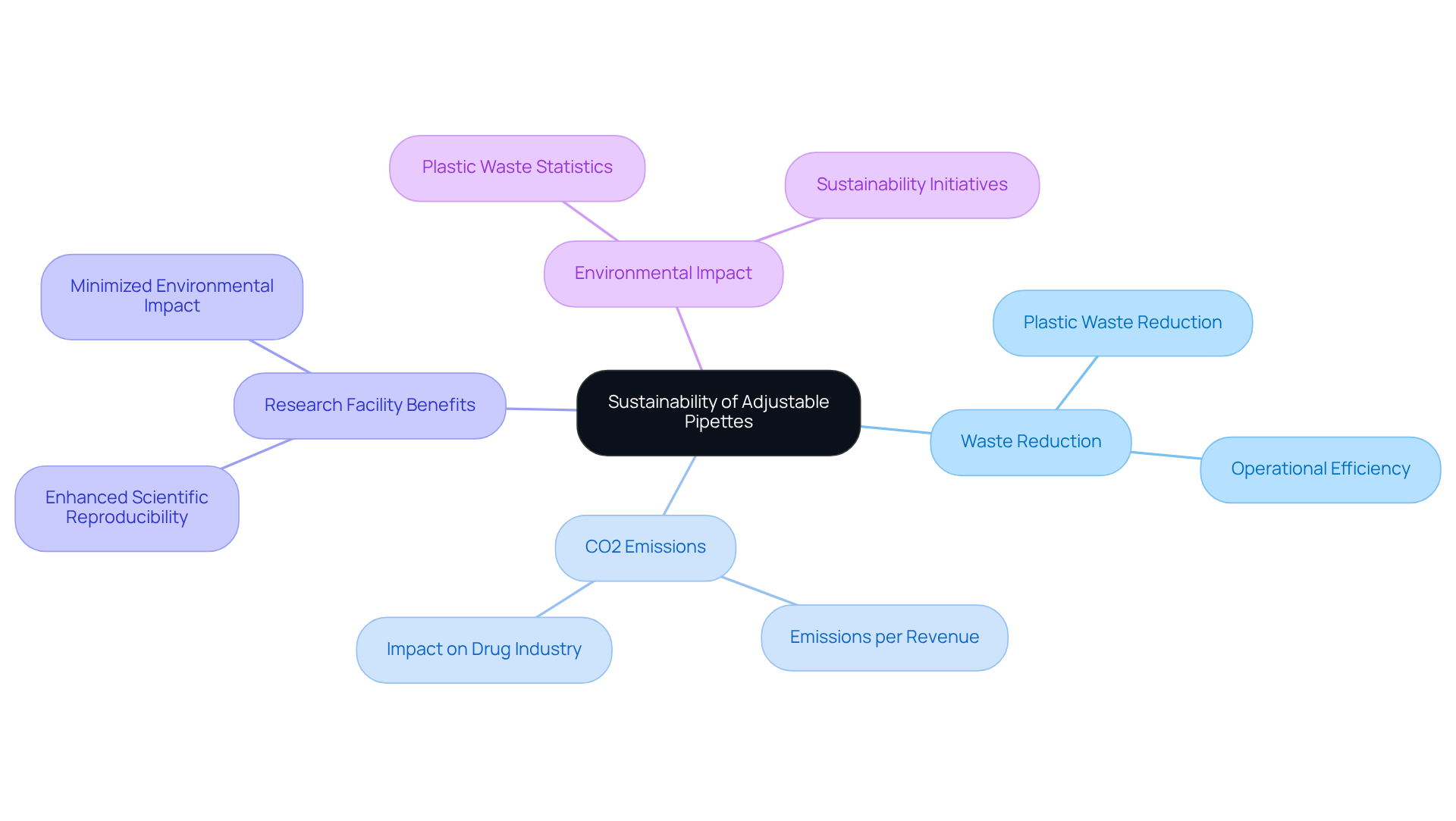
Easy Maintenance of Adjustable Pipettes: Ensure Lab Standards
Adjustable devices are engineered for effortless upkeep, a critical factor in ensuring optimal performance within drug research facilities. Regular cleaning and calibration are not only straightforward but can also be seamlessly integrated into daily lab routines. This simplicity in maintenance significantly aids facilities in , particularly in the pharmaceutical industry where adherence to standards is paramount.
Indeed, laboratories that implement consistent maintenance practices for their instruments report elevated compliance rates, thereby mitigating the risk of penalties linked to regulatory breaches. Quality assurance experts emphasize that maintaining standards through regular calibration and maintenance of an adjustable pipette is vital for guaranteeing precise liquid handling, which directly impacts experimental integrity.
By prioritizing the upkeep of adjustable pipettes, pharmaceutical laboratories can enhance their operational effectiveness and maintain the reliability of their results.
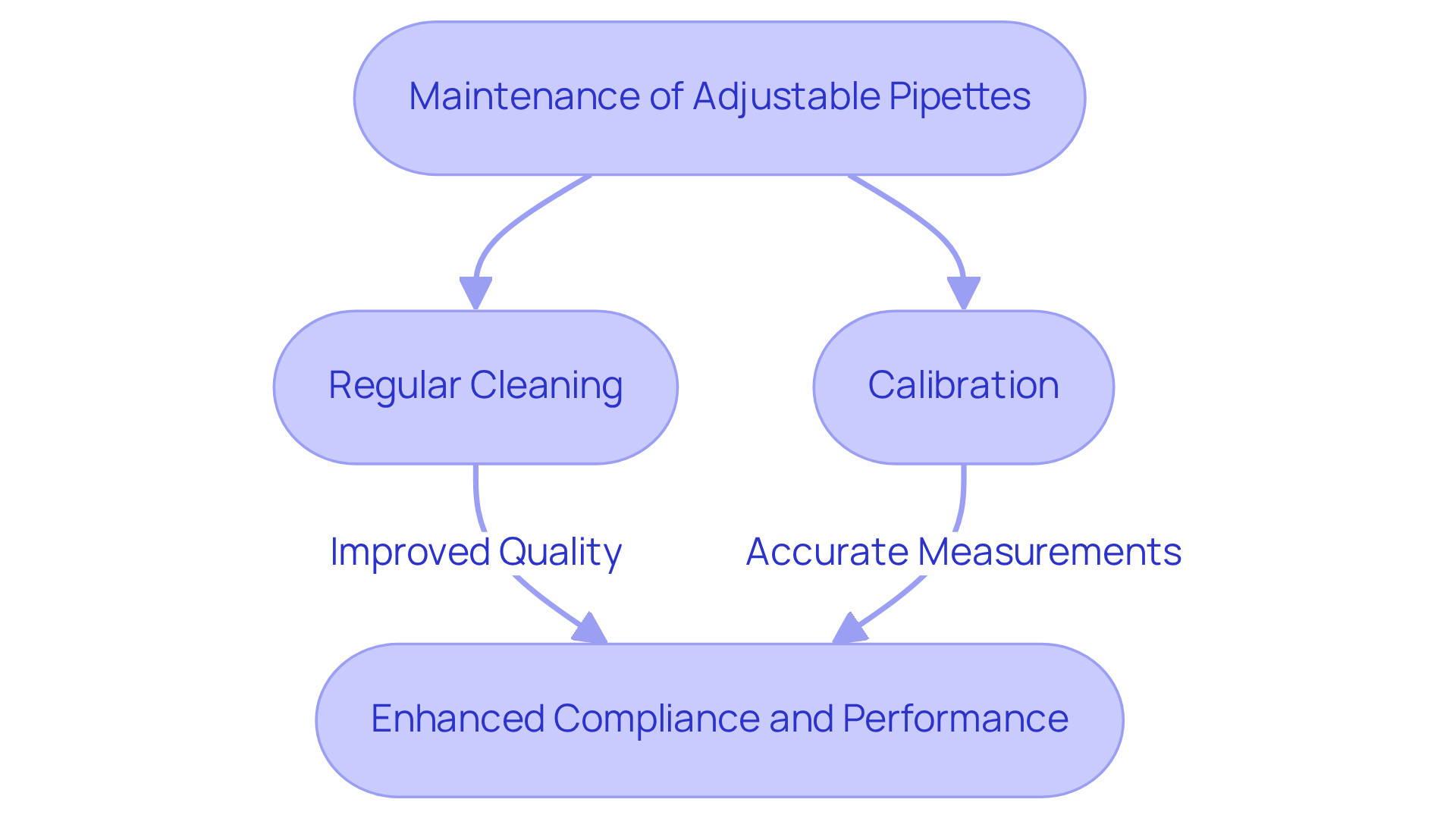
Training and Support for Adjustable Pipettes: Maximize Your Investment
JM Science offers comprehensive training and support for users of variable volume dispensers. This initiative encompasses:
- Instructional materials
- How-to videos
- Direct assistance from our knowledgeable staff
By investing in training, facilities can ensure their personnel are proficient in operating dispensers, thereby maximizing the benefits of their investment. Such training not only enhances operational efficiency but also underscores the in leveraging high-quality scientific instruments within laboratory settings.
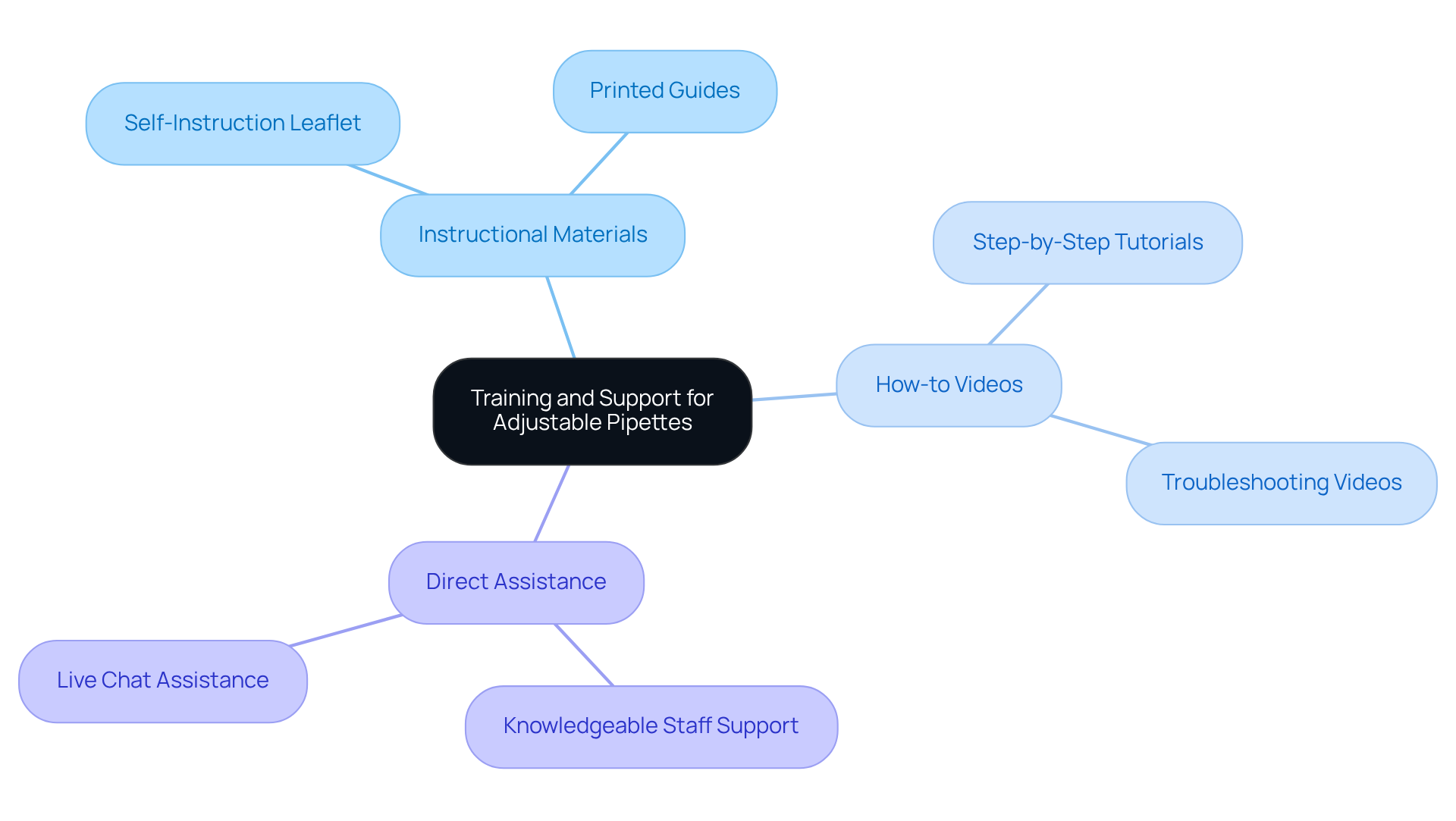
Innovative Technology in Adjustable Pipettes: Elevate Lab Performance
Recent advancements in flexible liquid dispensers have introduced cutting-edge technologies that significantly enhance functionality and user experience. Features such as digital displays for precise volume settings and automatic calibration are now standard, streamlining the pipetting process. These innovations not only enhance precision but also elevate overall laboratory performance, making adjustable pipettes essential instruments in contemporary pharmaceutical research.
Industry leaders emphasize that the integration of digital displays enhances usability, allowing for quicker adjustments and reducing the likelihood of human error. Statistics indicate a growing user adoption of , reflecting their critical role in elevating lab efficiency and precision.
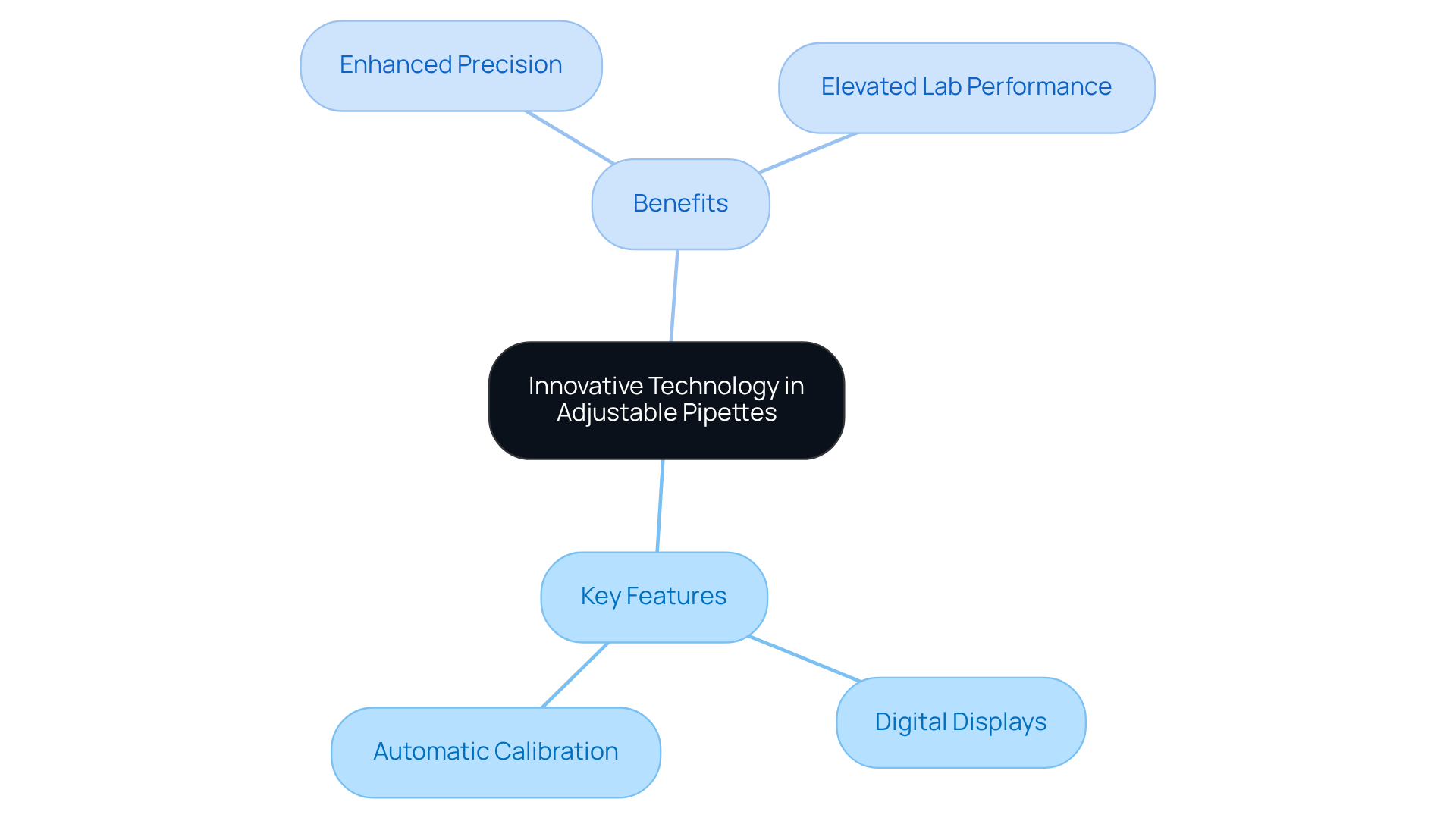
Conclusion
Adjustable pipettes are revolutionizing pharmaceutical laboratories by significantly enhancing precision, streamlining workflows, and promoting sustainability. These versatile instruments not only facilitate customizable liquid handling but also markedly reduce the risk of errors, resulting in more dependable experimental outcomes. Their ergonomic design, coupled with electronic features, further enhances user comfort and operational efficiency, establishing them as essential tools in the quest for accurate drug formulation and testing.
The article highlights key benefits of adjustable pipettes, including:
- Time-saving capabilities
- Cost-effectiveness
- Ease of maintenance
The integration of innovative technology has elevated their functionality, ensuring that laboratories can achieve high performance standards while minimizing environmental impact. Additionally, the emphasis on training and support underscores the necessity of maximizing the potential of these instruments for optimal laboratory outcomes.
In light of these insights, it is evident that adopting adjustable pipettes transcends mere convenience; it represents a strategic investment in the future of pharmaceutical research. As the industry evolves, embracing these advanced tools will be vital for enhancing productivity, ensuring accuracy, and fostering sustainable practices. Laboratories are urged to prioritize the integration of adjustable pipettes, not only to improve operational efficiency but also to align with the growing commitment to environmental stewardship within the scientific community.




